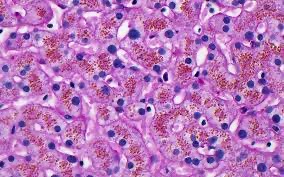 Lipofuscin refers to the fine yellow-brown pigment granules composed of lipid-containing residues of lysosomal digestion.
Lipofuscin refers to the fine yellow-brown pigment granules composed of lipid-containing residues of lysosomal digestion.
It is considered to be one of the aging pigments of wear and tear found in the liver, kidney, heart muscle, retina, adrenals, nerve cells, and ganglion cells.
Lipofuscin is the product of the oxidation of unsaturated fatty acids and may be symptomatic of membrane damage, or damage to mitochondria and lysosomes.
Aside from a large lipid content, lipofuscin is known to contain sugars and metals, including mercury, aluminium, iron, copper and zinc.
Lipofuscin consists of oxidized proteins (30–70%) as well as lipids (20–50%).
It is a type of lipochrome and is specifically arranged around the nucleus.
Its accumulation may be the result of an imbalance between formation and disposal mechanisms.
Lipofuscin accumulation in the eye, is a major risk factor implicated in macular degeneration, a degenerative disease, and Stargardt disease, an inherited juvenile form of macular degeneration.
In the peripheral nervous system, abnormal accumulation of lipofuscin known as lipofuscinosis is associated with a family of neurodegenerative disorders – neuronal ceroid lipofuscinoses, the most common of these is Batten disease.
Accumulation of lipofuscin is implicated in Alzheimer’s disease, Parkinson’s disease, amyotrophic lateral sclerosis, certain lysosomal diseases, acromegaly, denervation atrophy, lipid myopathy, chronic obstructive pulmonary disease, and centronuclear myopathy.
Accumulation of lipofuscin in the colon is the cause of the condition melanosis coli.
Myocardial lipofuscin accumulation more directly reflects chronological aging rather than human cardiac pathology.
A buildup of waste products in cells presumably interferes with metabolism, and the waste product lipofuscin is formed by a complex reaction in cells that binds fat to proteins.
Calorie restriction, vitamin E, and increased glutathione appear to reduce or halt the production of lipofuscin.
Wet macular degeneration can be treated using selective photothermolysis where a pulsed unfocused laser predominantly heats and kills lipofuscin-rich cells, leaving untouched healthy cells to multiply and fill in the gaps.
The technique is also used as a skin treatment to remove tattoos, liverspots, and in general make skin appear younger.
